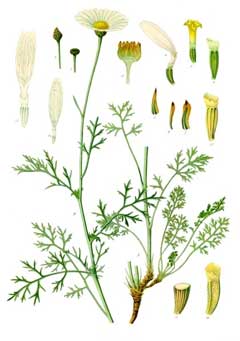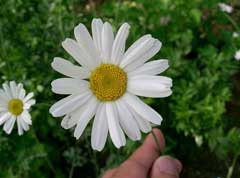 |
|
http://commons.wikimedia.org/wiki/File:Koeh-269.jpg |
 |
| http://commons.wikimedia.org/wiki/User:KENPEI |
Translate this page:
Summary
Physical Characteristics

 Tanacetum cinerariifolium is a PERENNIAL growing to 0.5 m (1ft 8in) by 0.5 m (1ft 8in).
Tanacetum cinerariifolium is a PERENNIAL growing to 0.5 m (1ft 8in) by 0.5 m (1ft 8in).
See above for USDA hardiness. It is hardy to UK zone 6 and is not frost tender. It is in flower from July to September, and the seeds ripen from August to September. The species is hermaphrodite (has both male and female organs) and is pollinated by Bees, flies. The plant is self-fertile.
Suitable for: light (sandy), medium (loamy) and heavy (clay) soils and prefers well-drained soil. Suitable pH: mildly acid, neutral and basic (mildly alkaline) soils and can grow in very alkaline soils.
It cannot grow in the shade. It prefers dry or moist soil. The plant can tolerate maritime exposure.
UK Hardiness Map
US Hardiness Map
Synonyms
Chrysanthemum cinerariifolium. Pyrethrum cinerariifolium.
Plant Habitats
Cultivated Beds;
Edible Uses
References More on Edible Uses
Medicinal Uses
Plants For A Future can not take any responsibility for any adverse effects from the use of plants. Always seek advice from a professional before using a plant medicinally.
Vermifuge
Dalmatian pellitory is not used medicinally, though research has shown that the flowers possess weak antibiotic activity[268]. The flowers are the main source of the insecticide pyrethrum, which is toxic to insects but not to mammals. It has sometimes been used as a vermifuge in China[147].
References More on Medicinal Uses
The Bookshop: Edible Plant Books
Our Latest books on Perennial Plants For Food Forests and Permaculture Gardens in paperback or digital formats.

Edible Tropical Plants
Food Forest Plants for Hotter Conditions: 250+ Plants For Tropical Food Forests & Permaculture Gardens.
More

Edible Temperate Plants
Plants for Your Food Forest: 500 Plants for Temperate Food Forests & Permaculture Gardens.
More

More Books
PFAF have eight books available in paperback and digital formats. Browse the shop for more information.
Shop Now
Other Uses
Insecticide Repellent
The dried flower buds are the source of the insecticide 'Pyrethrum'[1, 4, 14, 18, 46, 57, 61]. The pyrethrins are produced in the yellow disc florets[169]. The highest pyrethrin content is from the flowers when they are in full bloom (1.22%) and lowest in the preceding period (0.71%)[240]. This insecticide also kills many beneficial insects, though it is relatively harmless to mammals[4]. Another report says that it is non-toxic to mammals[238]. It is best used in the evening so that it will have lost much of its virulence by the morning[201]. Steep two handfuls of the dried powdered flowers in one litre of hot water for an hour. This mixture can be either pureed or strained and then used as a spray[201]. Once dried, the flowers or the powder retain their insecticidal properties almost indefinitely[238]. The growing plant can be used as an insect repellent in the garden[14, 18, 20]. Effective against mosquitoes and ants[201].
Special Uses
Carbon Farming
References More on Other Uses
Cultivation details
Industrial Crop: Pesticide Management: Hay Minor Global Crop
Succeeds in an ordinary garden soil[1]. Prefers a rich soil with plenty of humus[147]. Prefers a pebbly, calcareous dry soil in a sunny position[4]. When grown in moist climates the plants often die after flowering[4].Tolerates a pH in the range 5.2 to 7.5. Pyrethrum is widely cultivated as a source of an insecticide[57, 61], the growing plant is also said to repel insects from plants growing nearby[14, 18, 20].
Carbon Farming
-
Industrial Crop: Pesticide
Many plants provide natural pesticides.
-
Management: Hay
Cut to the ground and harvested annually. Non-destructive management systems maintaining the soil organic carbon.
-
Minor Global Crop
These crops are already grown or traded around the world, but on a smaller scale than the global perennial staple and industrial crops, The annual value of a minor global crop is under $1 billion US. Examples include shea, carob, Brazil nuts and fibers such as ramie and sisal.
References Carbon Farming Information and Carbon Sequestration Information
Temperature Converter
Type a value in the Celsius field to convert the value to Fahrenheit:
Fahrenheit:
The PFAF Bookshop
Plants For A Future have a number of books available in paperback and digital form. Book titles include Edible Plants, Edible Perennials, Edible Trees,Edible Shrubs, Woodland Gardening, and Temperate Food Forest Plants. Our new book is Food Forest Plants For Hotter Conditions (Tropical and Sub-Tropical).
Shop Now
Plant Propagation
Seed - sow spring in a greenhouse. Only just cover the seed and do not allow the pot to dry out. Prick out the seedlings into individual pots once they are large enough to handle and grow them on in the greenhouse for their first winter. Plant out in late spring or early summer. Division in spring. Larger divisions can be planted out direct into their permanent positions. We have found that it is best to pot up smaller divisions and grow them on in light shade in a greenhouse or cold frame until they are growing away well. Plant them out in the summer or the following spring.
Other Names
If available other names are mentioned here
Native Range
EUROPE: Albania, Bosnia and Herzegovina, Croatia, Montenegro
Weed Potential
Right plant wrong place. We are currently updating this section.
Please note that a plant may be invasive in one area but may not in your area so it's worth checking.
Conservation Status
IUCN Red List of Threatened Plants Status :

Growth: S = slow M = medium F = fast. Soil: L = light (sandy) M = medium H = heavy (clay). pH: A = acid N = neutral B = basic (alkaline). Shade: F = full shade S = semi-shade N = no shade. Moisture: D = dry M = Moist We = wet Wa = water.
Now available:
Food Forest Plants for Mediterranean Conditions
350+ Perennial Plants For Mediterranean and Drier Food Forests and Permaculture Gardens.
[Paperback and eBook]
This is the third in Plants For A Future's series of plant guides for food forests tailored to
specific climate zones. Following volumes on temperate and tropical ecosystems, this book focuses
on species suited to Mediterranean conditions—regions with hot, dry summers and cool, wet winters,
often facing the added challenge of climate change.
Read More
Expert comment
Author
(Trevir.)Sch.Bip.
Botanical References
50200
Links / References
For a list of references used on this page please go here
Readers comment